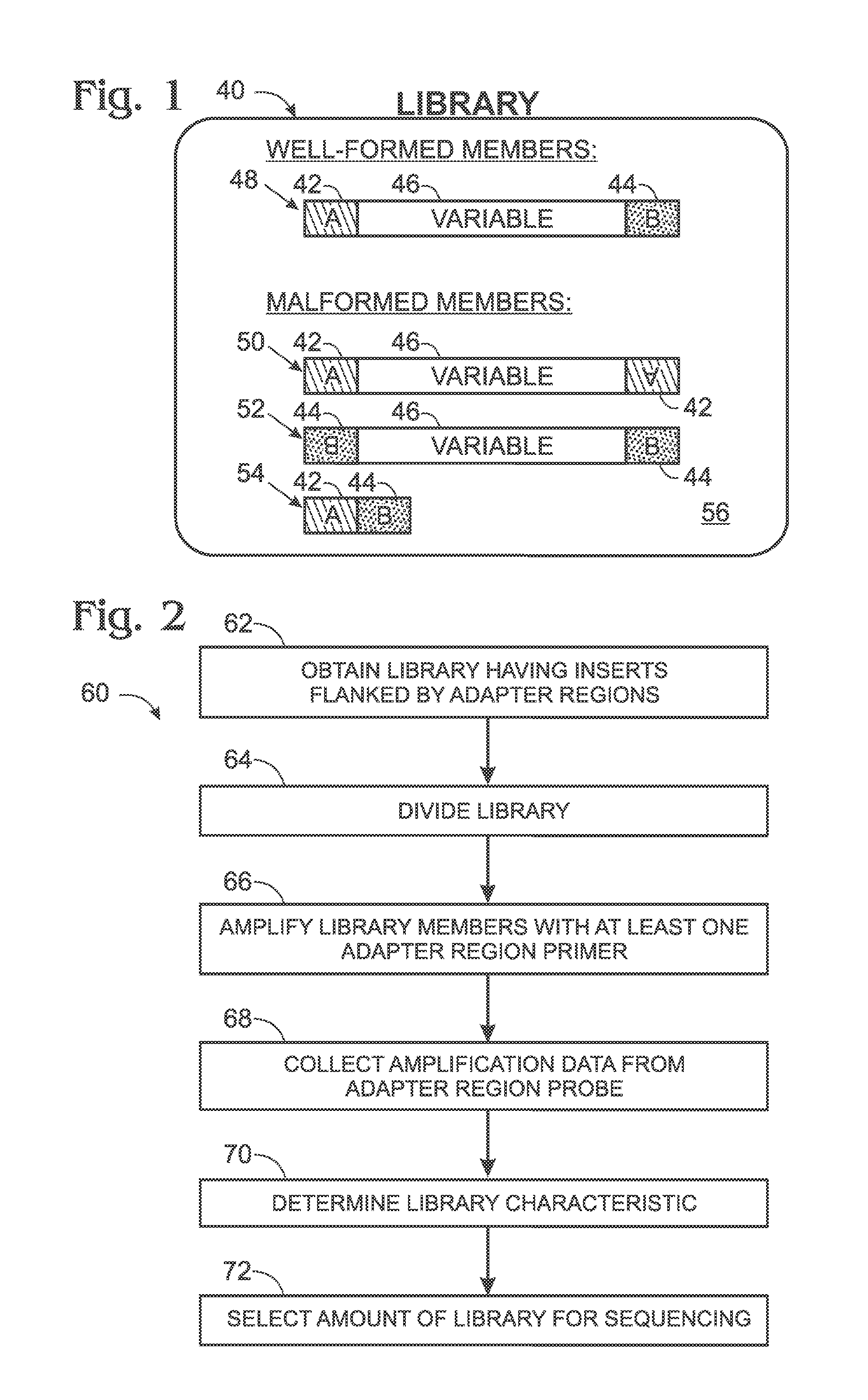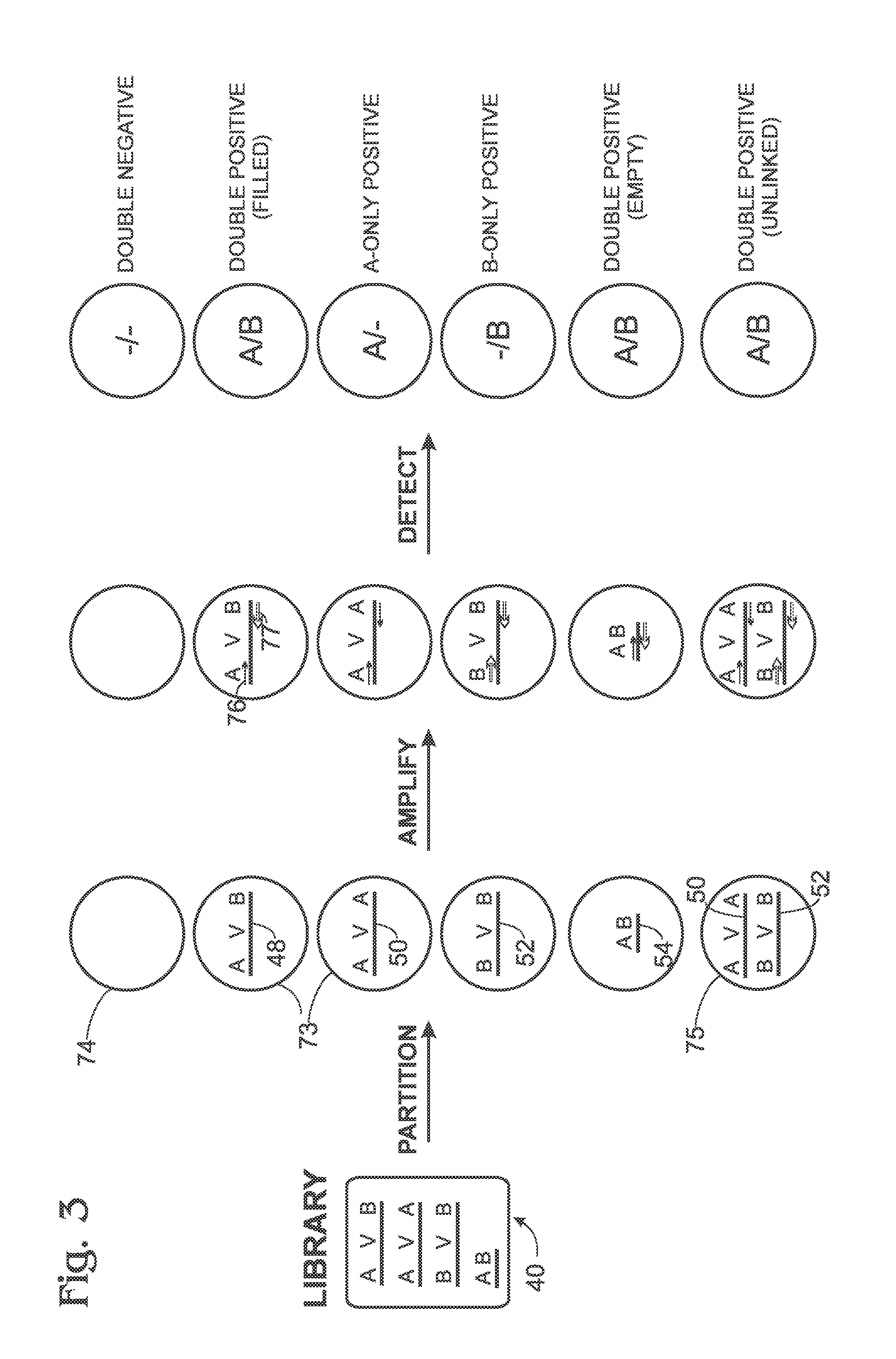Library characterization by digital assay
a library and digital assay technology, applied in the field of library characterization by digital assay, can solve the problem of limited scale up of sanger method for a very large number of samples
- Summary
- Abstract
- Description
- Claims
- Application Information
AI Technical Summary
Benefits of technology
Problems solved by technology
Method used
Image
Examples
example 1
Exemplary Reporter Configurations for Detecting Empty Members
[0080]This example describes exemplary reporter configurations for detecting empty (and / or empty and filled) members of a library; see FIGS. 8 and 9.
[0081]FIG. 8 shows a schematic representation of exemplary amplification primers (FP, RP) and probes 140, 160 bound to empty library member 54 and well-formed library member 48. Probe 140 binds to both types of library members and thus allows determination of the collective level of both types. In contrast, probe 160 includes an oligonucleotide 162 that binds selectively to empty members of the library having a junction sequence produced by direct attachment of adapter region 42 to adapter region 44. Accordingly, data collected from probe 160 can be used to determine a level of empty library members. In some cases, the level of empty library members may be compared to a level of amplified library members detected with probe 140.
[0082]FIG. 9 shows a schematic representation sim...
example 2
Exemplary Amplification Data and Calculations
[0083]This example describes exemplary amplification data and calculations for a library characterization; see FIGS. 10-12.
[0084]FIG. 10 shows a two-dimensional plot of exemplary amplification data, in arbitrary intensity units, obtained from droplets with the method of FIGS. 2 and 3, using a library constructed according to FIG. 5, and tested generally according to the primers and probes of FIG. 7. Amplification of adapter sequences in the droplets was detected with the dye FAM as L1 and the dye VIC as L2 (see FIG. 7). Accordingly, the presence of an amplified adapter A sequence in a droplet generated a stronger FAM signal, the presence of an amplified adapter B sequence generated a stronger VIC signal, and the presence of both A and B sequences generated stronger FAM and VIC signals detected for the same droplet.
[0085]In the plot, data detected for each droplet is represented by a data point. Five clusters or populations of data points ...
example 3
Selected Embodiments I
[0090]This example describes selected embodiments related to library analysis to quantify empty library members resulting from fusion of adapter sequences to each other in the absence of an intervening insert sequence during library construction, presented without limitation as a series of numbered paragraphs.
[0091]1. A method of quantifying empty members of a library, comprising: (A) selecting a library of members formed by ligation of at least one type of adapter with a collection of fragments, each library member having either (a) an insert from the collection flanked at each end by an adapter sequence or (b) a pair of adapter sequences ligated to each other without an intervening insert from the collection, to generate an empty member of the library; (B) determining a total level of the library members in a library sample based on amplification; (C) determining a level of the empty members in a library sample based on amplification; and (D) comparing the le...
PUM
| Property | Measurement | Unit |
|---|---|---|
| Size | aaaaa | aaaaa |
| Level | aaaaa | aaaaa |
| Luminescence | aaaaa | aaaaa |
Abstract
Description
Claims
Application Information
 Login to View More
Login to View More - R&D
- Intellectual Property
- Life Sciences
- Materials
- Tech Scout
- Unparalleled Data Quality
- Higher Quality Content
- 60% Fewer Hallucinations
Browse by: Latest US Patents, China's latest patents, Technical Efficacy Thesaurus, Application Domain, Technology Topic, Popular Technical Reports.
© 2025 PatSnap. All rights reserved.Legal|Privacy policy|Modern Slavery Act Transparency Statement|Sitemap|About US| Contact US: help@patsnap.com



